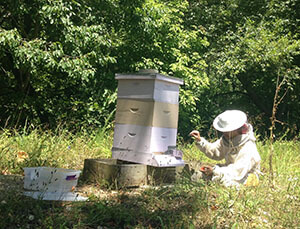
Honey bees recognize their sisters because their gut microbes make them smell similar
Serious question: If you close your eyes, can you imagine the smell of your brother, sister, mother or father? My guess is you probably can, even if it’s been a few years since you’ve thought about it. That’s because each of us has a characteristic smell, some of which may come from perfume or deodorant, but some of which definitely comes from us.
What does this have to do with bees? Well, it turns out bees also have a characteristic smell, or more specifically, characteristic cuticular hydrocarbons (CHCs). In addition to protecting bees from drying out, CHCs serve as pheromones that help bees recognize their nestmates. Indeed, guard bees at a colony’s entrance can recognize the similar CHCs of nestmates and accept them into the colony, or they can recognize the different CHCs of intruders and drive them away.
But how do CHCs become similar among nestmates? Are they genetically determined, or are they physically transferred and mixed among all bees in the colony environment? And what about all those microbes that live in and on bees — do they play a role in determining a bee’s CHC profile? These are the topics for our thirty-sixth Notes from the Lab, where we summarize “The gut microbiome defines social group membership in honey bee colonies,” written by Cassondra Vernier and colleagues and published in Science Advances [6:eabd3431].
For their study, Vernier and colleagues first created colonies using queens from three different sources — Georgia, California and New York. To assess whether CHC profiles were different among workers from each of the three colonies, they collected numerous foragers from each colony (Photo 1), then extracted and quantified 19 common CHCs using gas chromatography. This allowed the researchers to create a CHC “fingerprint” for each individual bee based on the relative proportion of each CHC.
Similarly, to assess whether the gut microbiota were different among workers from each colony, the authors collected numerous foragers from each colony, extracted DNA from their guts (Photo 2), then amplified and sequenced the bacterial DNA. This allowed the researchers to create a bacterial “fingerprint” of each worker based on the relative proportions of each species of bacteria.
Next, Vernier and colleagues tested whether a causal relationship existed between worker gut microbiota and CHCs. To do this, they first established whether colony-specific microbiota were acquired by newly emerged worker bees that were placed in a different colony. In other words, they took newly emerged workers from a colony, placed half of them in a new colony while allowing the other half to remain in the original colony, then compared the gut microbiota in bees that were transferred to those that stayed (Photo 3).
The authors then tested whether changes in microbiota led to predictable changes in CHC profiles by experimentally altering the microbiota in two ways — via antibiotics or microbe inoculations. For the inoculations, they compared the microbiota and CHCs of sister bees that either did or didn’t receive inoculations of live vs. heat-killed microbes, or microbes from one of two potential colonies.
Finally, Vernier and colleagues tested whether microbiota-mediated changes in CHCs led to changes in acceptance of intruders. To do this, they first showed that inoculating workers with two culturable gut bacteria — Gilliamella apicola or Lonsdalea quercina (Photo 4) — resulted in different gut microbiota and associated CHCs in sister bees. Next, they tested whether G. apicola-inoculated bees discriminated against L. quercina-inoculated bees, and vice versa, via intruder assays. Finally, they tested whether unrelated bees could develop similar nestmate recognition cues and be accepted when inoculated with the same microbe. To do this, they inoculated resident bees with G. apicola, then tested whether they accepted workers from that colony or a different colony that were inoculated with either G. apicola or L. quercina.
So, what did they find? Are gut microbes different among bees from different colonies? Yes. Among the three colonies tested, the gut microbes of sister bees were similar, but the gut microbes of bees from different colonies were different.
Are gut microbes fixed in a worker bee, or can they change according to the colony in which she’s raised? The gut microbes could change. Specifically, if a worker was raised in her own colony, she acquired the same microbiota as other workers in that colony. But if her sister was raised in a different colony, that sister acquired similar microbiota to workers in the other colony. In other words, a worker’s gut microbiota depend on the colony in which she’s raised, though they’re also influenced by her source colony/genetics.
What about cuticular hydrocarbons (CHCs)? Do gut microbes alter CHCs? Yes. And here’s where this paper really breaks ground in our understanding of honey bee and microbe biology. It didn’t matter whether Vernier and colleagues treated newly emerged worker bees with antibiotics, inoculations of live microbe inoculum vs. heat-killed inoculum, inoculum from older bees from two different colonies, or inoculum containing G. apicola vs. L. quercina; each of these treatments changed worker microbiota and led to corresponding changes in CHCs. In short, changing a worker bee’s microbiota always changed its CHCs.
Well that’s neat, but why is this important? Do microbiota-mediated changes in CHCs alter recognition between nestmates? Yes. And here Vernier and colleagues’ study breaks ground again. In their intruder assays (Photo 5) the authors found that G. apicola-inoculated bees discriminated against L. quercina-inoculated bees, but not vice-versa. Since G. apicola is a symbiotic gut microbe while L. quercina is an opportunistic microbe (in other words, G. apicola contributes positively to gut function, while L. quercina simply exists in the gut when it’s there), these results sug


